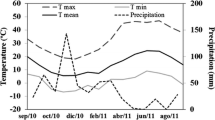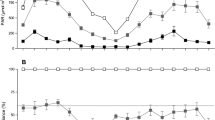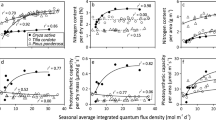Abstract
• Context
The effects of leaf inclination on plant light capture, growth, and water balance of monospecific canopies are well documented, but we still lack information on such effects in the case of multispecific canopies.
• Aims
We investigated the effects of leaf inclination on the absorption of photosynthetically active radiation (PAR) of a mixed forest.
• Methods
We ran a 3D mechanistic radiation transfer model for a Mediterranean forest where Pinus halepensis makes the upper strata while Quercus ilex occupies the lower strata. As factors, we included (1) the distributions of leaf inclinations that ranged from vertical to horizontal (including the actual inclinations), (2) the fraction of diffuse light, sun position, and leaf area index (LAI), and (3) the Pinus/Quercus LAI ratio.
• Results
Simulated PAR absorption was more than twice as sensitive to leaf inclination in oaks than in pines because oaks depended on PAR transmitted below the pine layer. The extent of the effect depended on season, fraction of diffuse light, LAI, and vegetation spatial structure. None of the observed inclinations maximized PAR absorption, suggesting a trade-off with water economy.
• Conclusion
Erroneous assumptions about leaf inclination lead to larger errors when modelling heterogeneous, mixed canopies. This also highlights potential caveats when using models that do not account for the spatial structure of canopies.






Similar content being viewed by others
References
Baldocchi DD, Wilson KB, Gu L (2002) How the environment, canopy structure and canopy physiological functioning influence carbon, water and energy fluxes of a temperate broad-leaved deciduous forest—an assessment with the biophysical model CANOAK. Tree Physiol 22:1065–1077
Barclay HJ (2001) Distribution of leaf orientations in six conifer species. Can J Bot 79:389–397
Bréda NJJ (2003) Ground-based measurements of leaf area index: a review of methods, instruments and current controversies. J Exp Bot 54:2403–2417
Campbell GS (1986) Extinction coefficients for radiation in plant canopies calculated using an ellipsoidal inclination angle distribution. Agric For Meteorol 36:317–321
Chen JM, Black TA (1992) Foliage area architecture of plant canopies from sunfleck size distributions. Agric For Meteorol 60:249–266
Chen JM, Rich PM, Gower ST, Norman JM, Plummer S (1997) Leaf area index of boreal forests: theory, techniques, and measurements. J Geophys Res 102:29429–29443
Combes D, Chelle M, Sinoquet H, Varler-Grancher C (2008) Evaluation of a turbid medium model to simulate light interception by walnut trees (hybrid NG38 × RA and Juglans regia) and Sorghum canopies (Sorghum bicolor) at three spatial scales. Funct Plant Biol 35:823–836
de Wit C (1965) Photosynthesis of leaf canopies. Center for Agricultural Publication and Documents, Wageningen
Ehleringer JR (1988) Changes in leaf characteristics of species along elevational gradients in the Wasatch front, Utah. Am J Bot 75:680–689
Falster DS, Westoby M (2003) Leaf size and angle vary widely across species: what consequences for light interception? New Phytol 158:509–525
Girard F, Vennetier M, Ouarmim S, Caraglio Y, Misson L (2011) Polycyclism, a fundamental tree growth process, decline with recent climate change: the example of Pinus halepensis Mill. in Mediterranean France. Trees 25:311–322
Gratani L, Bombelli A (2000) Correlation between leaf age and other leaf traits in three Mediterranean maquis shrub species: Quercus ilex, Phillyrea latifolia and Cistus incanus. Environ Exp Bot 43:141–153
Kim H-S, Palmroth S, Thérézien M, Stenberg P, Oren A (2011) Analysis of the sensitivity of absorbed light and incident light profile to various canopy architecture and stand conditions. Tree Physiol 31:30–47
King DA (1997) The functional significance of leaf angle in Eucalyptus. Aust J Bot 45:619–639
Kucharik CJ, Norman JM, Gower ST (1998) Measurements of leaf orientation, light distribution and sunlit leaf area in a boreal aspen forest. Agric For Meteorol 91:127–148
Le Roux X, Gauthier H, Bégué A, Sinoquet H (1997) Radiation absorption and use by a humid savanna grassland: assessment using remote sensing and modelling. Agric For Meteorol 85:117–132
López-Serrano FR, García-Morote A, Andrés-Abellán M, Tendero A, del Cerro A (2005) Site and weather effects in allometries: a simple approach to climate change effect on pines. For Ecol Manag 215:251–270
Massonnet C, Regnard JL, Lauri PE, Costes E, Sinoquet H (2008) Contributions of foliage distribution and leaf functions to light interception, transpiration and photosynthetic capacities in two apple cultivars at branch and tree scales. Tree Physiol 28:665–678
McMillen GG, McClendon JH (1979) Leaf angle: an adaptive feature of sun and shade leaves. Bot Gaz 140:437–442
Miglioretti F (1983) Phytoécologie des peuplements à Quercus ilex L. et Quercus pubescens Willd. en Gardiole de Rians (Var), approche méthodologique pour évaluer la phytomasse des taillis de chêne vert. PhD thesis, Université d’Aix-Marseille; p. 77
Moon P, Spencer DE (1942) Illumination from a non-uniform sky. Trans Illum Eng Soc 37:707–712
Niinemets U, Cescatti A, Rodeghiero M, Tosens T (2006) Complex adjustments of photosynthetic potentials and internal diffusion conductance to current and previous light availabilities and leaf age in Mediterranean evergreen species Quercus ilex. Plant Cell Environ 29:1159–1178
Pimont F, Dupuy J-L, Caraglio Y, Morvan D (2009) Effect of vegetation heterogeneity on radiative transfer in forest fires. Int J Wild Fire 18:536–553
Roderick ML, Farquhar GD, Berry SL, Noble IR (2001) On the direct effect of clouds and atmospheric particles on the productivity and structure of vegetation. Oecologia 129:21–30
Ryel RJ, Beyschlag W, Caldwell MM (1993) Foliage orientation and carbon gain in two tussock grasses as assessed with a new whole-plant gas-exchange model. Funct Ecol 7:115–124
Ryu Y, Sonnentag O, Nilson T, Vargas R, Kobayashi H, Wenk R, Baldocchi DD (2010) How to quantify tree leaf area index in an open savanna ecosystem: a multi-instrument and multi-model approach. Agric For Meteorol 150:63–76
Sekimura T (1995) The diversity in shoot morphology of herbaceous plants in relation to solar radiation captured by leaves. J Theor Biol 177:289–297
Simioni G, Le Roux X, Gignoux J, Sinoquet H (2000) Treegrass: a 3D, process-based model for simulating plant interactions in tree–grass ecosystems. Ecol Model 131:47–63
Sinoquet H, Le Roux X, Adam B, Améglio T, Daudet FA (2001) RATP: a model for simulating the spatial distribution of radiation absorption, transpiration and photosynthesis within canopies: application to an isolated tree crown. Plant Cell Environ 24:395–406
Sinoquet H, Sonohat G, Phattaralerphong J, Godin C (2005) Foliage randomness and light interception in 3-D digitized trees: an analysis from multiscale discretization of the canopy. Plant Cell Environ 28:1158–1170
Utsugi H, Araki M, Kawasaki T, Ishizuka M (2006) Vertical distributions of leaf area and inclination angle, and their relationship in a 46-year-old Chamaecyparis obtusa stand. For Ecol Manag 225:104–112
Wang W-M, Li Z-L, Su H-B (2007) Comparison of leaf angle distribution functions: effects on extinction coefficient and fraction of sunlit foliage. Agric For Meteorol 143:106–122
Werner C, Correia O, Beyschlag W (1999) Two different strategies of Mediterranean macchia plants to avoid photoinhibitory damage by excessive radiation levels during drought. Acta Oecol 20:15–23
Werner C, Ryel RJ, Correia O, Beyschlag W (2001a) Effects of photoinhibition on whole-plant carbon gain assessed with a photosynthesis model. Plant Cell Environ 24:27–40
Werner C, Ryel RJ, Correia O, Beyschlag W (2001b) Structural and functional variability within the canopy and its relevance for carbon gain and stress avoidance. Acta Oecol 22:129–138
Acknowledgments
We thank D Gounelle and A Jouineau (INRA-URFM) for their contributions to field measurements. We thank Dr H Davi (INRA-URFM) for providing leaf inclination data on Q. ilex. We thank an anonymous reviewer for helpful comments on a previous version of the manuscript.
Funding
The project was supported by an innovative research grant from INRA. Simulations were performed using HPC resources from GENCI-CINES (grant 2011-c2011016613).
Author information
Authors and Affiliations
Corresponding author
Additional information
Handling Editor: Erwin Dreyer
Contribution of the co-authors
G. Simioni supervised the field measurements, did all the modelling work (setting up simulations, running the model and analysing model outputs), made the figures and wrote the article. M. Gillmann, as part of her bachelor project, conducted the leaf inclination measurements on Pinus halepensis, did part of the literature review on leaf orientation, and contributed to the interpretation of the results. R. Huc contributed to the overall experimental design and to the interpretation of the results.
Rights and permissions
About this article
Cite this article
Simioni, G., Durand-Gillmann, M. & Huc, R. Asymmetric competition increases leaf inclination effect on light absorption in mixed canopies. Annals of Forest Science 70, 123–131 (2013). https://doi.org/10.1007/s13595-012-0246-8
Received:
Accepted:
Published:
Issue Date:
DOI: https://doi.org/10.1007/s13595-012-0246-8




